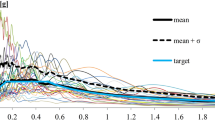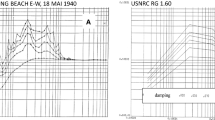Abstract
This study investigates the effect of damping on the seismic demands imposed on lightweight nonstructural components. The investigation was performed utilizing a total of 113 floor acceleration recordings obtained from instrumented buildings located in California. Results are presented as damping modification factors, which provide information on the seismic demands imposed on secondary systems with various levels of damping relative to 5% damped components. Evaluations of the results indicate a strong period dependence, with the effect of damping being much larger for components that are tuned or nearly tuned and much smaller for components with periods far from the modal periods of the supporting building. Therefore, a better characterization of the effect of damping is achieved if the damping modification factors are a function of the ratio of the period of the component to the modal periods of the supporting structure. As expected, record-to-record variability increases as the level of damping in the secondary component deviates from 5% damping, with an overall probability distribution that is approximately lognormal. Thus, a full probabilistic characterization of the influence of damping on component response is offered via a parametric, period- and damping-dependent model of the mean and lognormal standard deviation of the damping modification factor.










Similar content being viewed by others
References
American Society of Civil Engineers (ASCE) (2010) ASCE/SEI 7-10. Minimum design loads for buildings. American Society of Civil Engineers, Reston
Astroza R, Pantoli E, Selva F, Restrepo JI, Hutchinson TC, Conte JP (2015) Experimental evaluation of a rooftop-mounted cooling tower. Earthq Spectra 3(3):1567–1589
Baltzopoulos G, Vamvatsikos D, Iervolino I (2016) Analytical modelling of near-source pulse-like seismic demand for multi-linear backbone oscillators. Earthq Eng Struct Dyn 45(11):1797–1815
Benjamin JR, Cornell CA (1970) Probability, statistics and decision for civil engineers. McGraw-Hill, New York
Bommer JJ, Mendis R (2005) Scaling of spectral displacement ordinates with damping ratios. Earthq Eng Struct Dyn 34(2):145–165
Calvi PM, Sullivan TJ (2014) Estimating floor spectra in multiple degree of freedom systems. Earthq Struct 7:17–38
Center for Engineering Strong Motion Data (CESMD). http://www.strongmotioncenter.org. Accessed 2 May 2019
Cruz C, Miranda E (2018) First mode damping ratios inferred from the seismic response of buildings. In: 11th U.S. national conference on earthquake engineering, Los Angeles, California
Davalos H, Miranda E (2017) Effect of damping on displacement demands for structures subjected to narrow band ground motions. In: 16th world conference on earthquake engineering (16WCEE), Santiago, Chile
Di Sarno L, Petrone C, Magliulo G, Manfredi G (2015) Dynamic properties of typical consultation room medical components. Eng Struct 100:442–454
European Committee for Standardization (CEN) (2004) EN1998-1, Eurocode 8: design of structures for earthquake resistance—Part 1: general rules, seismic actions and rules for buildings, Brussels
Goel RK, Chopra AL (1997) Vibration properties of buildings determined from recorded earthquake motions. Earthquake Engineering Research Center, University of California, Berkeley
Gupta VK (1997) Acceleration transfer function of secondary systems. J Eng Mech 123(7):678–685
Hatzigeorgiou GD (2010) Damping modification factors for SDOF systems subjected to near-fault, far-fault and artificial earthquakes. Earthq Eng Struct Dyn 39:1239–1258
Kazantzi A, Vamvatsikos D, Miranda E (2018) Effect of yielding on the seismic demands of nonstructural elements. In: Proceedings of 16th European conference on earthquake engineering, Thessaloniki, Greece
Kazantzi A, Vamvatsikos D, Miranda E (2020) Evaluation of seismic acceleration demands on building nonstructural elements. J Struct Eng: ASCE (in review)
Lee JP, Chen C (1975) Vertical responses of nuclear power plant structures subject to seismic ground motions. In: 3rd SMiRT conference, London, United Kingdom, Paper K5/3
Lilliefors H (1967) On the Kolmogorov–Smirnov test for normality with mean and variance unknown. J Am Stat Assoc 62:399–402
Lin J, Mahin S (1985) Seismic response of light subsystems on inelastic structures. J Struct Eng: ASCE 111(2):400–417
Lucchini A, Mollaioli F, Bazzurro P (2014) Floor response spectra for bare and infilled reinforced concrete frames. J Earthq Eng 18(7):1060–1082
Lucchini A, Franchin P, Mollaioli F (2017) Uniform hazard floor response spectra for linear structures. Earthq Eng Struct Dyn 46(7):1121–1140
Medina RA, Sankarnarayanan R, Kingston KM (2006) Floor response spectra for light components mounted on regular moment-resisting frame structures. Eng Struct 28:1927–1940
Miranda E (1993) Evaluation of site-dependent inelastic seismic design spectra. J Struct Eng: ASCE 119(5):1319–1338
Miranda E, Ruiz-Garcia J (2002) Influence of stiffness degradation on strength demands of structures built on soft soil sites. Eng Struct 24(10):1271–1281
Miranda E, Taghavi S (2005) Approximate floor acceleration demands in multistory buildings. I: formulation. J Struct Eng: ASCE 131(2):203–211
Mollaioli F, Liberatore L, Lucchini A (2013) Definition of a model for the damping modification factor for near-fault records. In: ANIDIS 2013, Atti del XV Convegno ANIDIS L’Ingegneria Sismica in Italia, Padova
Moschen L, Adam C, Vamvatsikos D (2016) A response spectrum method for peak floor acceleration demands in earthquake excited structures. Probab Eng Mech 46:94–106
Mylonakis G, Gazetas G (2000) Seismic soil-structure interaction: beneficial or detrimental? J Earthq Eng 4(03):277–301
Newmark NM, Hall WJ (1973) Procedures and criteria for earthquake resistant design: building practices for disaster mitigation, building science series, vol 46. National Bureau of Standards, Washington, pp 209–236
NIST (2018) Recommendations for improved seismic performance of nonstructural components. Prepared by the Applied technology council for the U.S. National Institute of Standards and Technology, Gaithersburg, MD. https://doi.org/10.6028/NIST.GCR.18-917-43
Sadeghzadeh-Nazari M, Ghafory-Ashtiany M (2011) Influential parameters for the design of nonstructural components in multi-story buildings. In: 3rd ECCOMAS conference on computational methods in structural dynamics and earthquake engineering (COMPDYN 2011), Corfu, Greece
Satake N, Suda KI, Arakawa T, Sasaki A, Tamura Y (2003) Damping evaluation using full-scale data of buildings in Japan. J Struct Eng: ASCE 129(4):470–477
Soroushian S, Maragakis M, Zaghi AE, Echevarria A, Tian Y, Filiatrault A (2014) Comprehensive analytical seismic fragility of fire sprinkler piping systems. Technical report MCEER-14-0002
Sullivan TJ, Calvi PM, Nascimbene R (2013) Towards improved floor spectra estimates for seismic design. Earthq Struct 4(1):109–132
Taghavi S, Miranda E (2008) Effect of interaction between primary and secondary systems on floor response spectra. In: 14th world conference on earthquake engineering (14WCEE), Beijing China
Tolis SV, Faccioli E (1999) Displacement design spectra. J Earthq Eng 3(1):107–125
Villaverde R (1997) Seismic design of secondary structures: state of the art. J Struct Eng: ASCE 123(8):1011–1019
Vukobratović V, Fajfar P (2015) A method for the direct determination of approximate floor response spectra for SDOF inelastic structures. Bull Earthq Eng 13(5):1405–1424
Vukobratović V, Fajfar P (2016) A method for the direct estimation of floor acceleration spectra for elastic and inelastic MDOF structures. Earthq Eng Struct Dyn 45(15):2495–2511
Watkins D, Chui L, Hutchinson T, Hoehler MS (2009) Survey and characterization of floor and wall mounted mechanical and electrical equipment in buildings. Structural systems research project report SSRP 09/11, Department of Structural Engineering, University of California San Diego, La Jolla, CA
Whitman RV, Hong S-T, Reed J (1973) Damage statistics for high-rise buildings in the vicinity of the San Fernando Earthquake. Report no. 7, Massachusetts Institute of Technology, 204 pp
Acknowledgements
This work was partially supported by the Applied Technology Council through the ATC-120 project “Seismic Analysis, Design, and Installation of Nonstructural Components and Systems—Background and Recommendations for Future Work” and the National Institute of Standards and Technology (NIST). The substance of such work is dedicated to the public. Comments and suggestions by members of the project technical committee M. Phipps, J. Gillengerten, W. Holmes. B. Lizundia, R. Medina and R. Pekelnicky are gratefully acknowledged. The authors are solely responsible for the accuracy of statements or interpretations contained in this publication. No warranty is offered with regard to the results, findings and recommendations contained herein, either by the National Institute of Standards and Technology, the Applied Technology Council, its directors, members or employees. These organizations and individuals do not assume any legal liability or responsibility for the accuracy, completeness, or usefulness of any of the information, product or processes included in this publication.
Author information
Authors and Affiliations
Corresponding author
Additional information
Publisher's Note
Springer Nature remains neutral with regard to jurisdictional claims in published maps and institutional affiliations.
Rights and permissions
About this article
Cite this article
Kazantzi, A.K., Vamvatsikos, D. & Miranda, E. The effect of damping on floor spectral accelerations as inferred from instrumented buildings. Bull Earthquake Eng 18, 2149–2164 (2020). https://doi.org/10.1007/s10518-019-00781-3
Received:
Accepted:
Published:
Issue Date:
DOI: https://doi.org/10.1007/s10518-019-00781-3




